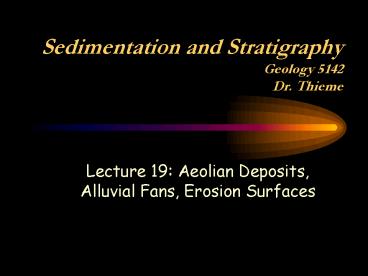Sedimentation and Stratigraphy Geology 5142 Dr' Thieme - PowerPoint PPT Presentation
1 / 24
Title:
Sedimentation and Stratigraphy Geology 5142 Dr' Thieme
Description:
Arid conditions where annual rainfall is less than 250 mm ... create 'herringbone' cross beds, where steeply dipping beds are oriented in ... – PowerPoint PPT presentation
Number of Views:34
Avg rating:3.0/5.0
Title: Sedimentation and Stratigraphy Geology 5142 Dr' Thieme
1
Sedimentation and StratigraphyGeology 5142Dr.
Thieme
- Lecture 19 Aeolian Deposits, Alluvial Fans,
Erosion Surfaces
2
Desert Environments
- Arid conditions where annual rainfall is less
than 250 mm - Semiarid were annual precipitation ranges from
250-500 mm - Most modern deserts have a winter season where
temperatures reach below 0ºC - Sparse vegetation due to low rainfall and cold
temps -gt wind blows unimpeded
3
Desert Sedimentary Facies
- Aeolian dune deposits of texturally and
compositionally mature sand - Wadi or alluvial fan deposits of poorly sorted
conglomerate or breccia - Playa lake sediments - evaporite minerals such as
gypsum and anhydrite, smectite clays, some
zeolites and other rare minerals
4
(No Transcript)
5
Aeolian Transport
- air has lower viscosity than water
- therefore higher velocities are required to
achieve enough lift force to raise particles up
off the bed into the free stream - while gusts may blow at up to 55 m s-1 (200 km
h-1) sustained wind velocities rarely exceed 30 m
s-1 - particles larger than 0.5 mm in diameter cannot
be entrained
6
(No Transcript)
7
(No Transcript)
8
Coarse particles, if entrained, also settle much
more rapidly out of air than water.
- Threshold below which falling velocity is
proportional to the square of the diameter - 0.18 mm for water
- 0.05 mm for air
9
Aeolian Transport
- saltation is much more effective in air because
the falling particles do not encounter as much
friction - for a given diameter, a grain transported in air
will - rise higher
- settle faster
- impact grains on the bed with more force
10
(No Transcript)
11
Wind Ripples
- piles of saltating grains align perpendicular to
the wind direction - separation and attachment point are closer
together than for sand of the same diameter
transported by water - faster falling velocity results in a "shadow
zone" on the lee side - coarsest grains concentrate at each crest
12
Aeolian Dune
- range from 10 cm - 100 m in height
- more than just a very large wind ripple because
one saltation "hop" will not carry grains between
dune crests
13
- dune and "draa" wavelengths are much larger than
the distance that sand grains travel in saltation
"hops" - very large sand grains occur on some wind ripple
crests - only dunes or "draas" have laminated "avalanche"
deposits on the lee side
14
(No Transcript)
15
Dunes and Bedforms
- Transverse dunes
- form under consistent, unidirectional winds
- with abundant supply of sand
- create planar cross beds as straight-crested
ripples migrate downwind - Barchan dunes
- form when sand supply is limited and winds are
more variable - form trough cross beds with steep dips
16
Dunes and Bedforms
- Linear or "seif" dunes
- form when there are two prominent wind directions
at approximately 90 - create "herringbone" cross beds, where steeply
dipping beds are oriented in different directions - Star dunes
- form in areas of multiple wind directions
- cross beds have greatest variety of directions
17
Steeply dipping crossbeds on an active linear dune
18
Cross-bedded Aeolian Sands
Planar cross-bedding in Wingate sandstone at
Arches National Park
Trough cross-bedding in Navajo sandstone, Zion
National Park
19
Facies found in an "interdune" area where aeolian
sands advance over inter-mittent marsh
20
Desert pavement or "serir" deposits form as fine
material filters downward and coarser clasts are
"borne at the surface"
"STONE LINE"
21
- Depositional subunits of an alluvial fan
- feeder canyon
- fan apex
- fan-head trench
- fan lobe
- fan toe
- Fan deposits resemble other alluvium but will be
reverse graded near the fan apex
22
- concentrated at the fan apex
- extend out and build a depositional lobe
23
Wadi gravel deposits often interfinger with
interdune muds and aeolian dune deposits
24
(No Transcript)































